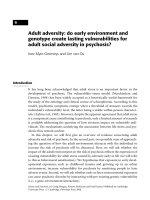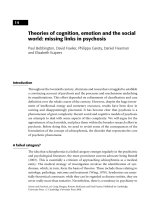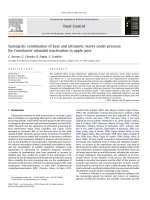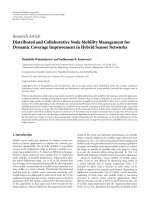Adult adversity - do early environment and genotype create lasting vulnerabilities for adult social adversity in psychosis
Bạn đang xem bản rút gọn của tài liệu. Xem và tải ngay bản đầy đủ của tài liệu tại đây (152.93 KB, 16 trang )
9
Adult adversity: do early environment and
genotype create lasting vulnerabilities for
adult social adversity in psychosis?
Inez Myin-Germeys and Jim van Os
Introduction
It has long been acknowledged that adult stress is an important factor in the
development of psychosis. The vulnerability–stress model (Nuechterlein and
Dawson, 1984) has been widely accepted as a heuristically useful framework for
the study of the aetiology and clinical course of schizophrenia. According to this
model, psychiatric symptoms emerge when a threshold of stressors exceeds the
individual’s vulnerability level, the latter being a stable within-person character-
istic (Zubin et al., 1983). However, despite the apparent agreement that adult stress
is a component cause contributing to psychosis, only a limited amount of research
is available addressing the question of how stressors impact on vulnerable indi-
viduals. The mechanisms underlying the association between life stress and psy-
chosis thus remain unclear.
In this chapter, we will first give an overview of evidence concerning adult
adversity and risk of psychosis. In the second part, two possible ways of approach-
ing the question of how the adult environment interacts with the individual to
increase the risk of psychosis will be discussed. First, we will ask whether the
impact of the adult environment on the risk of psychosis reflects the expression of
a lasting vulnerability for adult stress caused by adversity early in life (we will refer
to this as behavioural sensitisation). We hypothesise that exposure to early devel-
opmental exposures, such as childhood trauma and growing up in an urban
environment, increase vulnerability for psychosis by sensitising people to later
adverse events. Second, we will ask whether early or later environmental exposures
can cause psychotic disorder by interacting with pre-existing genetic vulnerability
(i.e., a gene–environment interaction).
Society and Psychosis, ed. Craig Morgan, Kwame McKenzie and Paul Fearon. Published by Cambridge
University Press. # Cambridge University Press 2008.
Adult social risk factors for psychosis
Adult life events
It has long been reported that patients suffering from schizophrenia are sensitive to
life events (e.g., Bebbington et al., 1993), defined as situations or occurrences that
entail a positive or negative change in personal circumstances (Brown and Harris,
1978). Life events have consistently been found to influence the course and out-
come of psychotic disorders, with a number of studies showing associations with
higher levels of symptomatology and increased relapse rates (Bebbington et al.,
1993; Bebbington et al., 1996; Carr et al., 2000; Norman and Malla, 1993).
However, both Bebbington et al. (1993, 1996) and Hirsch et al. (1996) have
suggested that life events do not directly trigger relapse in psychosis, but rather
contribute to a cumulatively increasing risk for psychosis with successive expo-
sures. Furthermore, it has been suggested that the experience of recent life events
might be particularly relevant in earlier episodes, as recurrent episodes (>3)
appear less related to the experience of life events (Castine et al., 1998).
Whereas most studies have relied on retrospective data, Ventura et al. (2000)
conducted a prospective study investigating a sample of recent-onset patients
diagnosed with schizophrenia over a period of 12 months. They found an
increased risk for both psychotic and depressive exacerbation following a life
event. Horan et al. (2005) compared this group of patients with a non-patient
control sample, and while patients reported a lower frequency of life events than
controls, they expressed diminished self-efficacy in their appraisals of the life
events, i.e., they rated them as less controllable and more poorly handled com-
pared with controls.
Two recent studies, based on data from the British National Psychiatric
Morbidity Survey, have extended previous findings to sub-clinical psychotic
experiences in the general population, which research suggests are on a phenomeno-
logical and aetiological continuum with clinical psychotic disorders (Johns
et al., 2004; Wiles et al., 2006). These found that the experience of adverse life
events during the preceding six months was associated, cross-sectionally and
longitudinally, with psychotic experiences (Johns et al., 2004; Wiles et al., 2006).
Finally, in a study of people at high risk for schizophrenia from the Edinburgh
High Risk study, it was found that a lifetime experience of stress, and particularly
upsetting life events, was associated with higher levels of psychotic symptoms at
the time of assessment (Miller et al., 2001). However, another study in individ-
uals with ‘at-risk mental states’ found recent life events not to be highly
predictive of transition to a psychotic disorder (Mason et al., 2004). This latter
finding fits with the notion of a cumulative rather than a triggering effect of life
events on psychosis.
128 I. Myin-Germeys and J. van Os
Discrimination and social defeat
Accumulating evidence suggests that migration is a putative risk factor for schizo-
phrenia (van Os et al., 2005; also see Chapter 10). Cantor-Graae and Selten
(2005), in a meta-analysis of 18 studies, found a mean relative risk for psychosis
of 2.7 (95% CI 2.3–3.2) in first-generation migrants and of 4.5 (95% CI 1.5–13.1)
in second-generation migrants. Migrants from developing countries had a higher
risk compared with migrants from developed countries (relative risk: 3.3, 95% CI
2.8–3.9) and migrants from countries where the majority of the population was
black had an increased risk for schizophrenia that was almost twice as great as that
for migrants from other countries.
It has been shown that the association between migrant status and psychosis is
not solely due to selection (Cantor-Graae and Selten, 2005). An alternative explan-
ation is that repeated experiences of discrimination and social defeat may increase
risk in migrant groups. This would fit with the finding that black migrants are
particularly at risk, since it is these groups who most often face discrimination in
Western societies (Cantor-Graae and Selten, 2005). A prospective study in a general
population sample reported that exposure to discrimination, be this due to age, sex,
appearance, sexual orientation or handicap, was associated with an increased
risk of psychosis (Janssen et al., 2003). Boydell et al. (2001) found that the incidence
of schizophrenia in non-white ethnic minorities increased in a dose–response
fashion as they formed a decreasing proportion of the local population.
Mechanisms (1) Sensitisation to stress
One mechanism through which environmental exposures might impact on the
risk for psychosis is sensitisation. Sensitisation indicates that a previous exposure to
adversity or stress makes individuals more sensitive or responsive rather than
more resistant to the later occurrence of stress. It is attractive to hypothesise that
previous exposure to social adversity might sensitise people to later stressors, thus
putting them at increased risk of psychosis.
Empirical evidence
To understand the mechanism of sensitisation it is pivotal to understand how
stress impacts on individuals who are at risk of developing psychosis. In a series of
studies by our group (for review see: Myin-Germeys and van Os, 2007), the effect
of small stressors and disturbances in the natural flow of daily life was investigated
in participants with different degrees of underlying vulnerability for psychosis.
Previously, it had been suggested that the course of psychosis is influenced not so
much by rare major life events but rather by the much more prevalent smaller
events that occur in the flow of daily life. Thus, minor daily events have been
129 Adult adversity
reported to have an impact on psychological symptoms in general (Kanner et al.,
1981; Monroe, 1983), subjective distress (Norman and Malla, 1991) and relapse
rates in schizophrenia (Malla et al., 1990).
We used the Experience Sampling Method (ESM) – a structured diary technique –
to investigate the impact of small stressors in the flow of daily life. The participants
in these studies were signalled 10 times daily during a six day period to prompt
completion of a questionnaire collecting reports of thoughts, current context
(activity, persons present, location), appraisals of the current situation and mood
after each signal (Myin-Germeys et al., 2001).
In one study, the ESM was applied to investigate how small daily life stressors affected
emotions in a sample of participants with differing degrees of vulnerability for psy-
chosis: patients diagnosed with psychosis in a current state of remission; first-degree
relatives of patients diagnosed with a psychotic disorder; and healthy controls.
Emotional reactivity to stress was defined as an increase in negative affect (NA) and a
decrease in positive affect (PA) associated with subjective appraisals of stress in daily life.
Negative affect consisted of the mood items ‘I feel anxious right now’, ‘I feel lonely right
now’, ‘I feel insecure right now’, ‘I feel irritated right now’, ‘I feel down right now’ and ‘I
feel guilty right now’. Positive affect was similarly defined as feeling happy, satisfied,
cheerful and relaxed. Stress was conceptualised as the subjectively appraised stress-
fulness of distinctive events and minor disturbances in the natural flow of daily life.
We found that underlying vulnerability to psychotic disorder modified emotional
responses to stress in daily life (see Myin-Germeys et al., 2001). The two vulnerable
groups (patients and relatives) reported a similarly significant decrease in positive
affect associated with stress, compared with controls. For negative affect associated
with stress, the relatives showed a significantly greater increase than the controls; the
patients reported an even larger increase in negative affect compared with the
controls. Thus, higher levels of familial risk for psychosis were associated with higher
levels of emotional reactivity to daily life stress in a dose–response fashion. These
data suggest that subtle alterations in the way persons interact with the environment
may constitute part of the vulnerability for psychosis. Part of this vulnerability to
daily life stress may be genetic, part may be environmental (see below).
In a further study, we investigated whether stress also has a direct impact on
moment-to-moment fluctuations in the intensity of psychotic experiences in daily
life (Myin-Germeys et al., 2005a). Given that delusions and hallucinations vary in
intensity, and that this variability may occur over weeks, days or even consecutive
moments, it is attractive to investigate the effect of daily stress on such fluctua-
tions. In the ESM booklets, symptom-relevant information is collected through
self-report items enquiring about hallucinations and experiences related to the
concept of delusions, such as ‘I feel suspicious right now’, ‘I am preoccupied by my
thoughts’ and ‘I feel controlled’. To investigate this, we recruited a sample of
130 I. Myin-Germeys and J. van Os
currently remitted patients at risk of relapse and first-degree relatives (Myin-
Germeys et al., 2005a), this latter group being, on average, at increased risk of
developing psychotic experiences, including subtle psychosis-like or schizotypal
experiences (e.g., Bergman et al., 2000). The data showed a clear association
between the occurrence of minor stresses and the intensity of psychotic experi-
ences. This effect was interpreted as evidence of behavioural sensitisation, since it
implies an enduring enhancement of the psychotic response to stress (Myin-
Germeys et al., 2005a). It could be argued that these findings do not suggest a
direct effect of stress on psychosis, but rather an artefact of increased negative
mood, which is also associated with daily stress. However, the effect of stress on
psychosis remained strong and significant after controlling for mood, suggesting a
direct effect of daily stress on psychosis, independent of mood.
Mechanisms (2) Early adversity and behavioural sensitisation
The studies described above demonstrate that people who are vulnerable to
developing psychosis are indeed sensitised to stress. They react with larger changes
in mood and psychosis intensity in response to daily stress compared with healthy
controls. Is this sensitised state, at least in part, the result of a sensitisation process
caused by early environmental adversity or only the result of an inherited vulner-
ability for psychosis?
Empirical evidence
To demonstrate a process of sensitisation consisting of an enduring vulnerability
caused by early environmental risk factors rather than genetic risk factors alone,
evidence showing alterations in current stress as a function of previous stressful
exposures is necessary. We investigated this in a sample of 42 patients in remission
from psychosis. Life events were assessed with the Brown and Harris Life Events
and Difficulties Schedule (Brown and Harris, 1978). We examined whether: (1)
the occurrence of life events in the past year moderated the subjective stressfulness
of daily hassles and (2) whether previous exposure to life events moderated emo-
tional reactivity to daily hassles, assessed using the ESM (Myin-Germeys et al.,
2003). We found that life events did not influence subjective appraisals of stress:
life events did not change the stressfulness of daily events, nor did life events
increase the appraised stressfulness of activities in which subjects were involved.
Life events, however, did moderate the emotional reactivity to stress both in
models predicting negative and positive affect (Figure 9.1).
Evidence suggests that recent life events also influence underlying biological
mechanisms in newly admitted patients with psychosis; in particular pre-treatment
cortisol may be increased after life events (Mazure et al., 1997). These results further
131 Adult adversity
support the hypothesis that environmental effects sensitise people to smaller
stresses encountered in daily life.
Another environmental risk factor associated with psychosis is the experience of
trauma or victimisation, particularly in childhood (see Chapter 7). It is attractive to
hypothesise that the relationship between childhood trauma and psychosis may in
part be mediated by lasting alterations in adult stress-sensitivity. We thus inves-
tigated the effect of childhood trauma on stress sensitivity in adult life in a sample of
90 frequent general practice attendees, a sample selected because of the high
prevalence of childhood trauma: 29 individuals had experienced serious trauma
during childhood (Glaser et al., 2006). The study examined whether childhood
trauma moderated emotional reactivity to small, daily life stressors, which were
again assessed using the Experience Sampling Method. The results showed that
subjects with a history of childhood trauma did indeed report increased emotional
reactivity to daily stress, reflected in an increase in negative affect. This effect was
significantly stronger for the subjects who experienced trauma before the age of 10
(Glaser et al., 2006). This provides some evidence for a long-lasting and enduring
effect of childhood trauma on adult stress-sensitivity. However, these data were
gathered in a normal population sample, and it is important to investigate these
questions in samples of subjects who are vulnerable to developing psychosis. In this
way, it may be possible to assess more fully the hypothesised causal chain from
trauma through behavioural sensitisation to psychosis.
Mechanisms (3) Biology and behavioural sensitisation
We have presented evidence to suggest that behavioural sensitisation may be one
mechanism linking the experience of previous larger stresses, such as significant
No life events
Life events
Increase in stress
Increase in negative
affect (NA)
.Figure 9.1 The effect of stress negative affect, stratified for the experience of life events in the past year,
in patients with psychosis
132 I. Myin-Germeys and J. van Os









